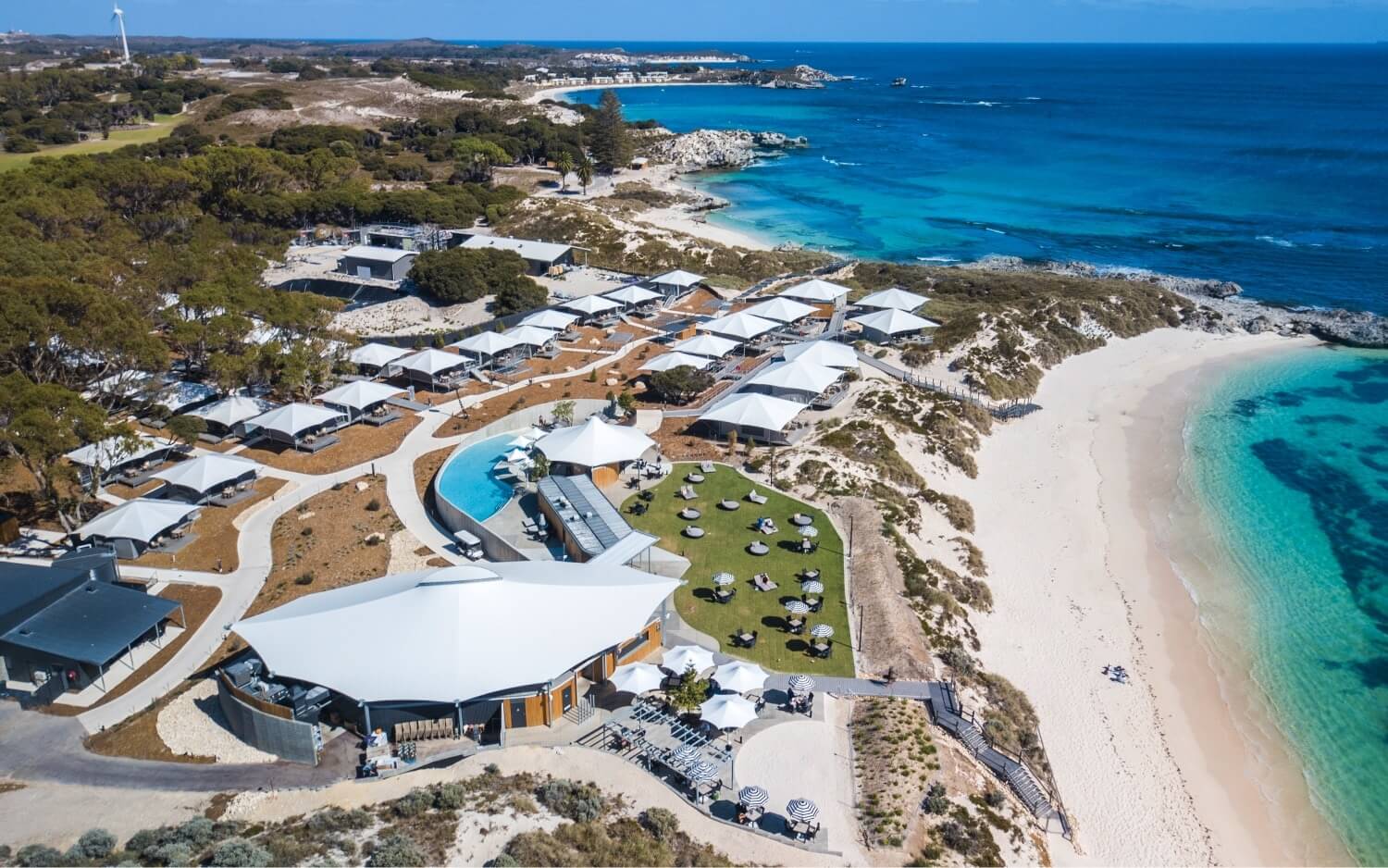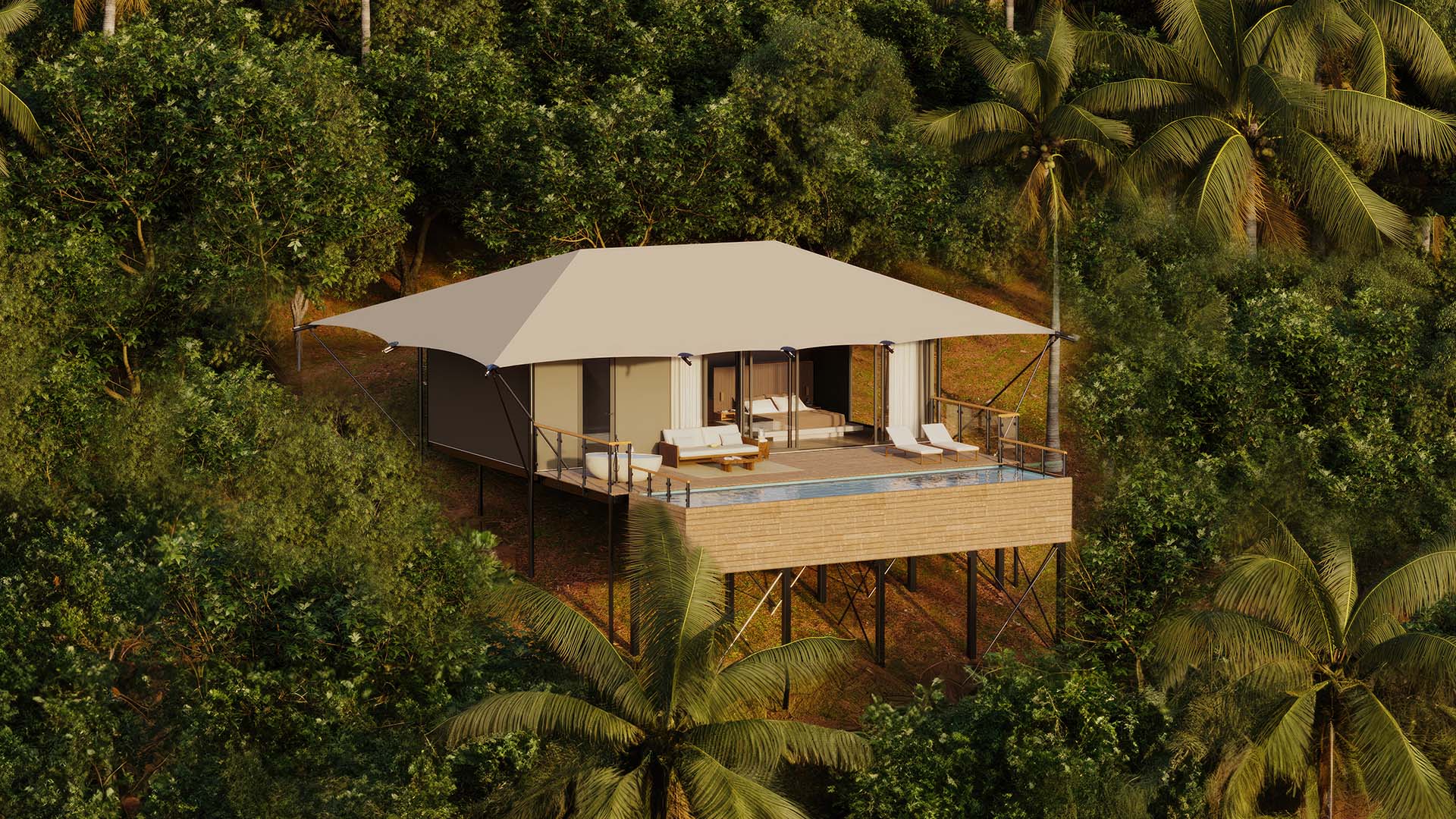Eco Anchors Explained: Building Without Disturbing the Earth
What Are Eco Anchors?
Eco Anchors are a smarter way to secure accommodation in sensitive environments. Designed by Eco Structures as a proprietary steel foundation system, these anchors are installed directly into sand, clay, or soil using a low-impact auguring method—no concrete, no curing, no excavation required. Like giant screws, they burrow deep into the earth to form a solid base for tent platforms and decking, while leaving the surrounding environment virtually untouched.
Unlike traditional footings, Eco Anchors allow you to build where others can’t. They offer a scalable solution for sites that demand environmental sensitivity, from national parks and Class A Reserves to island ecotourism developments and heritage-listed terrain.
Note: While ideal for soft and moderate ground types, Eco Anchors are not suitable for rock-heavy locations. Where solid rock is present, alternative foundation systems, such as concrete or customised mechanical footings, may be required.
Quick Summary
- A patented, concrete-free anchoring system designed for tents and decks
- Minimal ground disturbance, making them ideal for soft terrain like sand or clay
- Fast to install with lightweight tools ensures no curing or excavation
- Suitable for protected areas including World Heritage sites and Class A Reserves
- Reduces transport, labour and site preparation costs
- Easy to remove without trace ensures they perfect for leasehold or temporary builds
- Not suitable for solid rock installations
- Used on landmark projects across Australia and globally
Why Choose Eco Anchors Over Traditional Concrete?
No Concrete, No Curing, No Excavation
The typical concrete footing process is invasive, resource-heavy and slow. It involves digging up the earth, pouring large amounts of concrete, waiting for it to cure, and in many cases transporting those materials to remote or inaccessible locations. Eco Anchors skip this step entirely. Augured into the ground like a screw, they leave vegetation and topsoil intact, protect root systems, and avoid compaction or erosion often caused by excavation.
This makes them ideal for culturally significant or biodiversity-rich environments where preserving the landscape is non-negotiable.
Lightweight Installation Process
There’s no need for excavators, concrete trucks, or heavy machinery. Eco Anchors are installed using a pneumatic hammer and minimal manual labour. For remote builds with tight access, limited infrastructure, or rugged terrain, this simplicity translates into faster deployment and a smaller on-site footprint. Our system enables developers to start building the same day—rather than waiting for concrete to cure.
Faster Build Times and Lower Costs
Because Eco Anchors require less machinery, fewer trades, and dramatically shorter install times, they reduce both upfront labour costs and the environmental cost of logistics. There’s no need to transport tonnes of concrete to site, no need for specialist excavation teams, and no weather-related curing delays.
The result: a quicker, cleaner and more cost-effective way to create sustainable accommodation, without compromising on durability or structural performance.
Where Eco Anchors Work Best
Ideal Ground Conditions
Eco Anchors are engineered for soft to moderately firm ground types. Sand, clay, loam and mixed soils all provide ideal substrates for installation. The auguring method used to drive the steel rods into the ground ensures strong, stable footing, without the need for concrete or surface preparation.
No grading. No excavation. No disruption. This makes them the perfect match for coastal dunes, bushland clearings, and lakefront terraces where nature should be preserved, not replaced.
Eco Anchors are not suitable for rock-heavy or solid stone terrain. In these rare cases, we provide alternate foundation recommendations to suit project needs without compromising structural integrity.
Environmentally or Culturally Sensitive Areas
From World Heritage sites to Class A Reserves, Eco Anchors have become the go-to system for developers needing to build with a light touch. Traditional foundations often violate the ecological or cultural thresholds of these areas, but our anchors are designed to avoid the very impacts that make other systems unsuitable.
Because they don’t disturb root systems or alter the natural lay of the land, they’ve been used in conservation zones, heritage-listed terrain, and locations where local governments require complete site reversibility. The small footprint means natural flora, biodiversity, and even underground ecosystems remain undisturbed.
And when the time comes to decommission? The anchors are easily removed, leaving no concrete, no scars, and no trace.
Temporary or Lease-Based Projects
In regions where long-term leases (typically 10–15 years) are offered, such as Indigenous land, coastal tourism zones or national parks, Eco Anchors deliver unmatched value. They provide all the structural performance of a permanent footing, while giving operators peace of mind that the system can be removed cleanly and quickly at the end of the lease period.
This flexibility is a critical asset when working in protected areas that demand site restoration upon exit. Rather than jackhammering concrete or excavating piers, Eco Anchors are simply unscrewed from the ground, restoring the site to its natural state with minimal effort.
Real Projects, Real Impact
Eco Anchors have been proven across some of the most logistically complex and environmentally sensitive sites on the planet. From World Heritage Islands to rugged national parks, they’ve enabled meaningful builds without compromising place, ecology or operational efficiency.
Swell Lodge – Christmas Island
Set atop the volcanic cliffs of Christmas Island, Swell Lodge had one key requirement: build without disturbing a thing. Concrete was out of the question, and traditional excavation wasn’t permitted. Eco Anchors provided a zero-disturbance foundation method that secured each tent while preserving fragile terrain and ensuring full removability at the end of lease.
Why it worked:
- Protected native species and coastal terrain
- Enabled construction without heavy equipment
- Delivered a premium eco retreat within strict conservation guidelines
Karijini Eco Retreat – Pilbara, WA
Karijini National Park is home to deep gorges, ancient geological formations, and culturally significant lands. Excavating here wasn’t just impractical—it was impossible. Eco Anchors offered a minimal-impact solution to secure tents in shifting soil without compromising the surrounding heritage.
Why it worked:
- Eliminated need for concrete on sacred and rocky ground
- Respected local cultural values and land conditions
- Avoided terrain disturbance during both install and operation
Rottnest Island Eco Retreat – WA
On Rottnest Island, transport cost and impact were major concerns. Bringing in concrete by barge was cost-prohibitive and logistically burdensome. Eco Anchors enabled lightweight construction using compact transport loads and on-site installation without affecting the dune systems or native vegetation.
Why it worked:
- Reduced transport footprint and cost
- Preserved coastal flora and topsoil
- Accelerated install timeline for quicker ROI
Each of these projects highlights the flexibility and foresight behind our Eco Anchor system—delivering scalable, removable, and regulation-ready foundations where conventional construction simply isn’t viable.
Engineered, Certified and Proven
Eco Anchors aren’t just innovative, they’re certified, patented, and precision-engineered to perform under pressure. Developed as part of our modular construction methodology, each anchor system is designed and manufactured under our ISO 9001:2015 quality management system, ensuring consistency, safety, and global compliance.
Eco Anchors are just one part of a broader system designed for minimal waste, maximum flexibility, and long-term durability. Combined with our lift kits, steel subfloors, and prefabricated components, they help us deliver glamping solutions that work in harmony with the environment.
Whether you’re building on the coast, in a reserve, or deep in the outback, our team ensures every anchor and structure is tailored to the land beneath it.
Build Light. Leave No Trace.
Eco Anchors are more than a smart alternative to concrete, they represent a mindset. A shift away from outdated, high-impact construction toward a system that respects the ground it stands on. They’re quick to install, simple to remove, and powerful enough to support high-end accommodation, even in the most remote or restricted environments.
For developers operating on Class A Reserves, World Heritage sites, or culturally sensitive land, Eco Anchors open up opportunity without closing the door on sustainability. You don’t have to choose between impact and experience. With the right foundations, you can have both.
At Eco Structures, we build for the future. And that starts with the ground up. Talk to our team to see how Eco Anchors can work for your next project.








